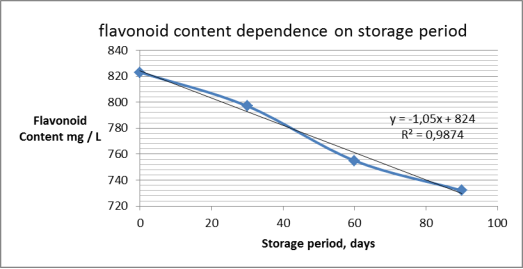Flavonoids are a large class of plant polyphenols — antioxidants. The richest sources are berries, because of their content of coloring agents as well as their leaves that contain natural preservatives. Flavonoids have recently been used as micro-components in functional and specialized food. However, the use of flavonoids as preservatives in beverage for the special purpose is not known, but it is very relevant. This contrast of flavonoid properties seems to bring economic benefit. The need to use preservatives (E number) is eliminated. This fact has a significant impact on consumer demand. The source of bioflavonoids is the dry extracts of fruit and berries. During the research it was necessary to find the optimal strength of the extract which provided the required amount of flavonoids and at the same time guaranteed microbiological stability.
Abstract: Flavonoids are a large class of plant polyphenols — antioxidants. The richest sources are berries, because of their content of coloring agents as well as their leaves that contain natural preservatives and vitamins with P activity. Flavonoids have recently been used as micro-components in functional and specialized food. Flavonoids regulate blood viscosity and promote normal blood clotting. Flavonoids are used to build a biological basic substance in cells, namely ubiquinone (coenzyme Q).
Materials and methods: Dry extracts of grapes and currants were selected as research material. Permanganometric titration and modern autotitrator were used to determine the physical and chemical properties. Proper culturing according to the GOSF (State Standart) was made to define the microbiological contamination of the beverage.
Results: Flavonoids seem to be used as micro-components in functional and specialized food. However, properties of flavonoids as preservatives in beverage for the special purpose are not known, but they are very relevant. This contrast of flavonoid properties seems to bring economic benefit. The need to use preservatives (E number) is eliminated. This fact has a significant impact on consumer demand. The source of bioflavonoids is the dry extracts of fruit and berries. It is obvious that flavonoids perform a dual function both physiological and technological.
Conclusion: It is the functional drink for preventive or general purposes that is based on grape and currant juice with a high content of flavonoids, which will be enriched in the form of extract mixture. It is biologically active as well as it is a safe alternative to the preservative (E number).
Keywords: strength of flavonoids, microbiological stability, analysis, molds, antioxidant effect, pasteurization, storage period.
Currently, the gradual increase in demand for beverages for the special purpose results from the desire of Russians to lead a healthy life. Depending on the beverage composition manufacturers of such beverages aim to produce beverages affecting on different human body systems. The component composition of such beverages is quite diverse.
It should be noted that the use of juice for the above beverages does not make any economical sense since all the active substances of particular value are not always constant and stable because of the certain environmental factors such as climate, harvesting, soil, seasonal weather. Therefore, the content of those substances do not always correspond to the declared quantity. Using dry extracts ensures a fixed amount of flavonoids and and thereby provides microbiological stability. It is proved that the grape tannins inhibit the growth of yeast of Candida genus. According to the conducted research of 1 % solution of the dry blackcurrant extract it was found that it had a constant bactericidal activity against Pseudomonas aeruginosa and with the higher strength it has weak bactericidal activity against Staphylococcus aureus.
Recent research of dry extract preservative action was carried out to the beverage for the special purpose on the basis of juices and teas. Beverage components themselves have a strong antioxidant effect and beneficial effect on the internal systems of the body, in particular on the cardiovascular system, namely strengthening the walls of blood vessels and preventing platelet aggregation on the walls.
Having been analyzed the range of fruit and berry extracts the black currant leaf extract, black grape peel extract and black grape stem and seed extract were selected because those extracts like the other ones have the highest content of flavonoids and anthocyanins and, therefore, they have the most powerful antioxidant effect.
Two mixtures were evaluated to prove the preservative effect of flavonoids. They consisted of the above three selected extracts with the total content of flavonoids of 57mg and 285 mg. Furthermore, those amounts of flavonoids constitute 60 % of the lowest limit (100 mg / day)of the daily requirement and 60 % of the top one(500 mg / day).
Since the heat treatment is essential in any beverage production technology the preservative effect of flavonoids was researched before and after the pasteurization.
Microbiological analysis of non — pasteurized beverage.
Two samples of beverage with different extract mixtures were made. They have been described above. Those samples were inspected for the content of microorganisms. The results are shown in the chart 1.
Chart 1
The microbiological analysis results of the beverage with the different extract content
|
Product name Beverage |
The number of colonies forming units in 1 gram |
|
|
MAFAnMQ |
Molds |
|
|
Exposure for X hours at Y temperature |
||
|
72 hours,t 30–31С° |
120 hours,t 24–25С° |
|
|
Beverage without extracts |
15 |
18 |
|
The flavonoid strength of 11.5 mg / 100 ml |
10 |
12 |
|
The flavonoids strength of 57 mg / 100 ml |
4 |
6 |
MAFAnMQ -Mesophilic Aerobic and Facultative Anaerobic Microorganisms Quantity
According to the results it can be concluded that the higher the strength of the extracts, the less the beverage is deteriorated and thus, the extracts inhibit the growth of microorganisms in beverage. Since the flavonoid strength for the extract content of 0,57 mg / ml is higher, therefore, that one was selected for research.
The extracts do not completely inhibit the growth of microorganisms, but their content is in accordance with the Sanitary Regulations 2.3.2.1078–01 for fruit juices pasteurized and carbonated with ph of 3.7 and less than that factor, but the mold content of 5 units does not meet the requirements of the above Regulations. That is why the proper temperature range having minimal impact on native flavonoids of juice in beverage was selected. The optimal temperature of pasteurization is t = 80–85S ° C for 2.5–5 minutes. The extracts were inserted into the beverage after the heat treatment and then microbiological analysis was conducted again. The results are shown in the chart 2.
Table 2
The microbiological analysis results of the beverage with the different extract content
|
Product name Bevarage
|
The number of colonies forming units in 1 gram |
|
|
MAFAnMQ |
Molds |
|
|
Exposure for X hours at Y temperature |
||
|
72 hourst=30–31С° |
120 hourst=24–25С° |
|
|
Pasteurized beverage without extracts |
5 |
6 |
|
Pasteurized beverage — the strength of flavonoids 0,0115 g / 0,1 dm3 |
3 |
4 |
|
Pasteurized beverage — the strength of flavonoids 0,057 g / 0,1 dm3 |
0 |
1 |
As a result it can be concluded that the use of extracts and pasteurization completely destroys MAFANMQ and partially destroys molds. It allows to use extracts as preservatives together with pasteurization, which enhances microbiological stability. The content of microorganisms is normal in accordance with the Sanitary Regulations 2.3.2.1078–01 for fruit juices pasteurized and carbonated with ph of 3.7 and less than that factor.
Since the flavonoid content of the beverage may fall during the storage period it was decided to conduct further research to confirm the findings of the earlier research. The beverage was placed in the store. The dependence of the flavonoid content of pasteurized extract beverage on storage time is shown in the chart 3 and the graph 1.

Fig 1. The dependence of the flavonoid content of pasteurized extract beverage on storage time: the regression equation takes the form of a polynomial function: y = 0,0002x3–0,0283x2–0,2111x + 823; R² = 1 (selection accuracy of the regression equation)
On the assumption of the obtained experimental data it seem to be concluded that the flavonoid content of non-pasteurized extract beverage falls during the three month storage period. According to the evaluation the flavonoid content fell by 11 % after the three month storage period.
Conclusion:
The above three extract beverage was researched and evaluated. The extracts were inserted into the beverage after the pasteurization and they were evaluated according to the lowest and highest limits of the daily requirement of 100 mg / day and 500 mg /day.
The optimal flavonoid content of 0,57 mg/ml was selected. It provided the maximum microbiological stability of the finished beverage.
Most natural extracts contain flavonoids which have a strong biological effect. Moreover, they have strong antioxidative and bactericidal properties.
Food additives (E number) which are usually inserted into beverage seem to be partially or totally replaced by the researched extracts.
References:
- http://www.terra-aromatica.ru/contact_us.php (dry extracts)
- http://aromarti.ru/ (dry extracts)
- https://ru.wikipedia.org/wiki/flavonoids (classification of flavonoids)
- http://www.tryphonov.ru/tryphonov2/terms2/vitnP.htm
- VA Marcos, NM Ageev, RV Gabl,2007. «Phenolic compounds in berries under different conditions of growing grapes» USA, California — № 4. — P 24–25. Journal Winemaking and Viticulture.
- V.N Golubeva, 2003. «Food and dietary supplements». ISBN 5–7695–1175–3. P-208. The publishing center «Academy»
- Khasanov A.R, Iureva L.V 2015 «The usage of natural flavonoids in functional drinks». Russia, Kazan. № 3 (83) P- 298–300. Journal of a young scientist in ISSN 2072–0297.
- Sharma, R. 2005 «Market trends and opportunities for functional dairy beverages». Australia. № 2. — P. 196–199. The Australian journal of dairy technology,
- LA Dogaeva, NT Pekhtereva 2011. Classification and identification features of functional soft drinks, Russia, Moscow N 5. — P. 62–65. — ISSN 2072–9650. Journal Beer and beverage.
- SanPiN 2.3.2.1078–01 Hygienic requirements of safety and nutritional value of food products 1078–01 Hygienic requirements of safety and nutritional value of food products







